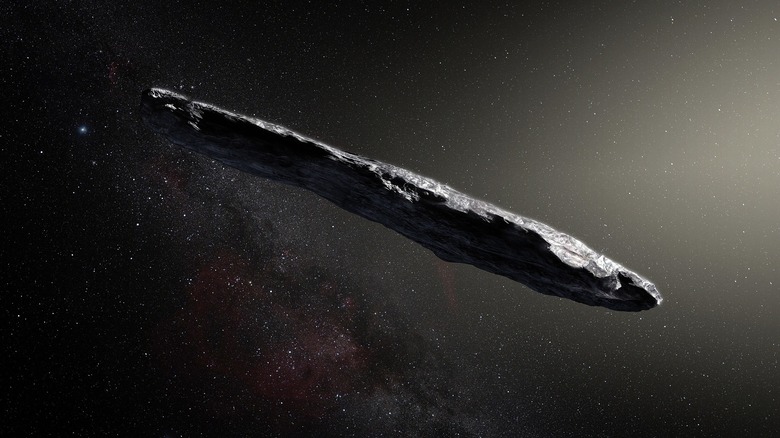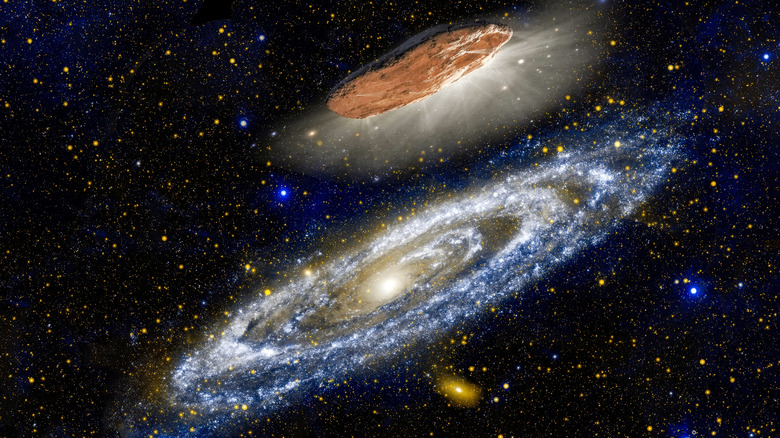The Strange, Cigar-Shaped Asteroid That Had Astronomers Fascinated
As the James Webb Telescope continues to prove, space is big. There may be only eight planets in our solar system, but there are 400 billion planets in the Milky Way ... the galaxy, not the candy bar. The total number of planets in the universe might be as high as 21.6 sextillions. Written out long-hand that's 21,600,000,000,000,000,000,000,000. Again, space is massive.
Zipping around all that vastness is a bunch of junk. According to NASA, there are 3,743 known comets, affectionately called "dirty snowballs," with billions more likely floating around in the Kuiper Belt and Oort Cloud. Currently, 1,113,527 known asteroids reside in our solar system alone. One can only imagine how many we don't know about beyond our immediate galactic zip code.
Over the last 4.54 billion years, our planet has been hit by asteroids, comets and meteorites, like the asteroid that buzzed the Tunguska River in Siberia, Russia, back in 1908. Another piece of space debris, which could have either been an asteroid or a comet, took out the real-life Jurassic Park some sixty-six million years ago. So knowing about these objects ahead of time is crucial in potentially avoiding another devastating extinction level event.
On October 19, 2017, Robert Weryck was operating the Panoramic Survey Telescope and Rapid Response System (Pan-STARRS1) on Maui as part of NASA's Near-Earth Object Observations (NEOO) Program when he discovered something very, very odd.
There's no smoking in space
At the time, Weryck was looking for asteroids that might get too close to Earth and thought an unusually-shaped object he saw was one such asteroid. But he wasn't sure after finding additional images that showed its orbit "didn't make sense" (via NBC News). Digging further into the collected data, he, along with colleague Marco Micheli at the European Space Agency, found that it had passed by the sun on September 9 of that year, going 196,000 miles per hour (via NASA), and was quickly heading out of our solar system (via Space). By calculating its incoming trajectory, they determined it must have come from outside our solar system, making this celestial cigar the first interstellar object ever recorded.
Over the next eleven days, the world aimed numerous ground and space-based telescopes at the object known as 1I/2017 U1 (the "1" stood for first and the "I" for interstellar) to collect as much data possible about this never before seen object before it vanished. Initially, it was labeled a comet, then changed to an asteroid, but it was doing things that neither are typically known to do.
Scientists concluded it was "no more than 3,000 feet by 400 feet" (via NBC). Overall, the rust-colored cigar-shaped object was "at least seven times as long as it is wide" and spun on its axis end over end every 7.4 hours, per NBC News.
Is it a messenger from afar?
It was, in every sense, an out-of-this-world anomaly. Thus, it was given the nickname 'Oumuamua, which means "a messenger from afar arriving first" in Hawaiian (via NASA).
After analyzing its orbital trajectory, astronomers believe 'Oumuamua came from the general direction of the Lyra constellation (via NASA), which contains the bright star, Vega. Once it reached our inner solar system, it took a hard left at the sun using a gravity assist technique commonly referred to as a gravitational slingshot, which sent it past Mars, Jupiter, and Saturn. If it stayed on that same heading, it would eventually reach the Pegasus constellation.
As it sped away, scientists discovered that it had somehow increased speed, which was highly unusual. In a paper co-written by Micheli for the journal Nature, he and his fellow astronomers concluded that something was affecting 'Oumuamua's trajectory and speed. However, co-author Davide Farnocchia from the Center for Near Earth Object Studies (CNEOS) thinks the speed boost was the result of natural jets of gas ejecting from the surface (called outgassing), acting like thrusters on a spaceship.
Except... 'Oumuamua was thought to be "completely inert." Karen Meech (another co-author of the paper and astronomer at the University of Hawaii) and team scientist Olivier Hainaut of the ESA both agreed that there were no apparent signs of outgassing, like a visible comet's tail.
Stop the madness!
However, some new findings may change our understanding of 'Oumuamua. It's much smaller than the half-mile length it was first estimated to be, and its most prominent side is anywhere between 33 and 330 feet wide and possibly as small as 147 by 144 by 24 feet. Its shape is more like a pancake than a cigar.
Some scientists believe 'Oumuamua was made of solid nitrogen, a form of ice seen on the surface of both Pluto and Triton, and could help explain many of its weird actions (via Space). Others find this unlikely since pure nitrogen is scarce in the universe.
All of this conflicting data has led some to ... other conclusions. Harvard astronomer Avi Loeb thinks 'Oumuamua was some kind of alien technology, perhaps an old probe or a solar sail, which might account for its acceleration as it left the solar system.
One other thing happened to add to all the confusion. In 2019, a second interstellar object named 2I/Borisov entered the solar system, but this visitor looked and acted like a regular old comet. We'll probably never know precisely what 'Oumuamua was, but we wish it safe travels through the cosmos.

